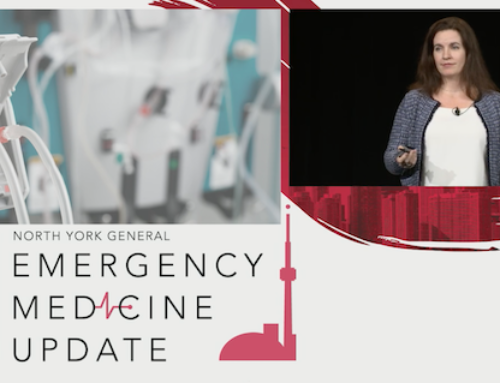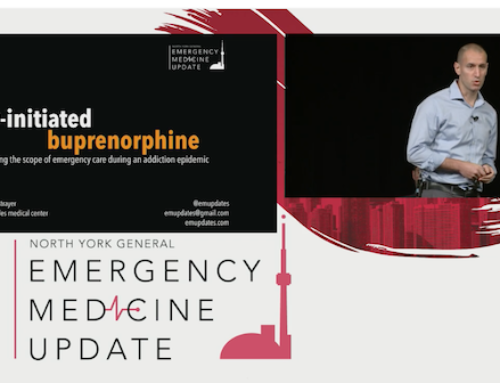EMU 365: The Crashing Asthmatic
A crashing asthmatic patient rolls into your resuscitation bay. They are cyanotic with a thready pulse and a silent chest. What is your medical management algorithm? How do you manage intubation and ventilation in these patients? And what do you do post-intubation? At EMU 2019, Dr. Mike Betzner takes us through one of his best cases ever with a crashing asthmatic patient and discusses how to respond to the most severe asthma presentations.
Dr. Betzner’s treatment priorities in severe asthma
- Oxygenate
- FiO2 100% to start via assisted NRBM with 5 of PEEP (RR no more than 10/min)
- Epi (IM and IV)
-
- Small child 0.15mg (1:1000) IM
- Medium sized child 0.3mg (1:1000) IM
- Large child/adult 0.5mg (1:1000) IM
- Then 0.5-1cc 1:100,000 Epi IV or IO q1min slow push to effect
- Mixed as cardiac Epi from the 10mL amp of 1:1000, waste 9mL of it. Add the remaining 1mL to 9mL Normal Saline giving 1:100,000 or 10mcg/mL
- Asthma/allergy kitchen sink
- Diphenhydramine 50mg IVPB
- Ranitidine 50mg IVPB
- When air is moving
-
- Continuous nebs: salbutamol 5mg, ipratropium 0.5mg x 3 then q4hr
- Steroid: methylprednisolone 2mg/kg or dexamethasone 0.6mg/kg
- MgSO4 2-4g over 10min (25-50mg/kg)
- +/- IV salbutamol 4mcg/kg IVP 15min if HR <120
- Give 5-10min to turn around…if all that fails
Intubating and ventilating the crashing asthmatic
-
- Keep patient sitting while preparing to intubate
- Ketamine 1-2mg/kg IV
- Succinylcholine 1.5mg/kg or rocuronium 1.5g=mg/kg
- Forced exhalation before connection to circuit
- Slow BVM ventilation &/or very conservative initial ventilator settings
- Cautious CO2 reduction with permissive hypercapnea until lung function improves
- RR 6-8 to reduce barotrauma
- Low tidal volume (6-8mL/kg)
- Low I:E ratio
- NaHCO3 as needed to keep pH>7.2 (controversial)
- May need to switch to pressure control mode if peak airway pressures or plateau pressure >40
If you can’t get airway pressures down and can’t oxygenate
- Consider barotrauma
- Maintain paralysis
- Inhalational anesthesia can be effective
- ECMO
Speaker Bio
Dr Mike Betzner is a graduate of University of Alberta Medical School in 1991 and completed his residency in 1996. He is a full time Emergency Physician and Clinical Lecturer for U of C in the Calgary Health Region. He was voted by the residents as FRCPC preceptor of the year for Emergency Medicine at U of C in 2013. Mike has been Medical Director of STARS Air Ambulance in Calgary for >15 yrs. He is still an active flight physician for STARS and involved in Pre-hospital, rural, and residency Emergency Medicine Education and Human Patient Simulation.




Leave A Comment